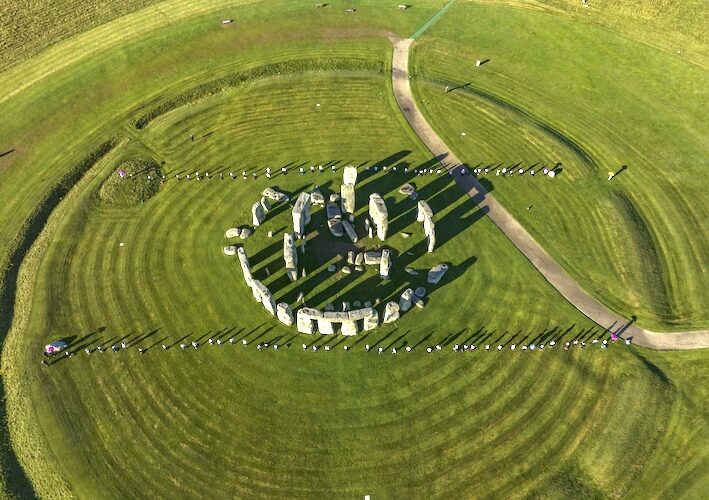Local school children gather to mark out alignments of moonrise and moonset at the ancient monument
This Autumn, English Heritage invites you to embark on a journey through time as together we explore the connection between the Moon and Stonehenge during the Major Lunar Standstill – a rare astronomical event occurring only every 18.6 years.
Spanning 2024 and 2025, this celestial phenomenon provides a unique opportunity for exploration, research and community engagement.
Experts believe that the Major Lunar Standstill may have played a pivotal role in the design and purpose of Stonehenge and this week, to launch a season of lunar activities, 90 children from Larkhill Primary and Stonehenge School gathered with Stonehenge Curator Heather Sebire, along with Dr Fabio Silva and Dr Amanda Chadburn from Bournemouth University, for a special aerial photo to capture the possible alignment of the moon at Stonehenge.
The alignment of the four Station Stones, highlighted by the children in the photo, coincides with the southernmost moonrise, or looking the other way, the northernmost moonset, sparking debate about whether this alignment was intentional.
This year and next present a unique opportunity to investigate this connection further and in the coming months, English Heritage will host a variety of activities on-site, online, and offsite for schools, families, and the community to celebrate and deepen our understanding of Stonehenge, our relationship with the Moon and our connection to nature and the passage of time.
Upcoming Major Lunar Standstill themed events
September 15: Chinese Moon Festival at Stonehenge The Moon Festival, one of the largest festivals in mainland China, has been celebrated for over 3,000 years, and this weekend, the Chinese Association of Southampton will bring their celebrations to Stonehenge, featuring dance, music, dragon performances, Kung Fu, and Tai Chi. Visit English Heritage website for details
September 23-24: Moonrise at Chimney Rock, Colorado – Online event Stonehenge will be connecting with another ancient site, Chimney Rock National Monument in Colorado, a prominent rocky ridge topped with two tall pinnacles, overlooking a river valley. This site was significant for the ancestral Puebloan people, who inhabited it from 925 to 1125AD. The rocks, visible from ancient structures, frame the moonrise during the Major Lunar Standstill. Tree ring dating indicates periods of construction linked to these lunar events, suggesting Chimney Rock was a place for observing and celebrating the Moon’s movements.
Stonehenge will be making a special virtual appearance at Chimney Rock, where gathered crowds will be watching a spectacular moonrise between the two pillars. If you are lucky enough to be in Colorado on 23 or 24 September, or on 21 October, you can join the late-night moonrise celebration at the accessible Visitor Centre amphitheatre, which will include film, talks, live music, and a live-stream of the moonrise from the upper mesa, courtesy of Griffith Observatory of Los Angeles.
See the event description and make a reservation to attend at https://www.recreation.gov/ticket/facility/234787 (search for Chimney Rock National Monument).
October 26 – Dec 31: Major Lunar Standstill exhibition Discover a new special display at the Stonehenge visitor centre focusing on ongoing research about the Moon’s influence on this iconic site and the people who built and used it.
October 26 – November 3: Moons and Megaliths at the Stonehenge Planetarium Step inside the pop-up planetarium and embark on a journey through the solar system with an expert astronomer. Learn how to identify celestial objects such as stars, planets, and the Moon as we observe the night sky over the ancient stone circle. Visit English Heritage website for details.
December 3: The Kaaba and Stonehenge: Moonsighting from Stonehenge Site Join in for a unique experience exploring the celestial connections between Stonehenge and the Kaaba – the most sacred site in Islam. Discover how the Kaaba is carefully aligned with the sun, moon, and stars, and learn about the fascinating parallels with Stonehenge’s astronomical alignments.
Learn about the Islamic lunar calendar, in which each month begins with the sighting of the new crescent Moon. That makes astronomy a key part of Islamic events and festivals, including Ramadan and Eid. Join Imad Ahmed of the New Crescent Society and help conduct the moonsighting for the Islamic month of Jumada al-Thani. This crescent is particularly significant, as it occurs during the ‘major lunar standstill’, and it will be the southern-most setting crescent in the Moon’s 19 year cycle. Observing this special crescent from Stonehenge is a rare opportunity not to be missed!
Visit English Heritage website for details.
December – February: Lunar storytelling at Stonehenge Join in each winter weekend to explore moon myths, beliefs and stories from various cultures, including Druids and Native Americans. Discover what these perspectives reveal about people’s relationship with the moon throughout history and across different cultures.
Early 2025 – Major Lunar Standstill lectures Don’t miss lectures on the Major Lunar Standstill hosted by the Society of Antiquaries, the Royal Astronomical Society and Bournemouth University.
For teachers and schools Special educational programs, including the Festival of Neolithic Ideas and Teacher Twilight sessions, will also be available for schools. For more details, please contact email hidden; JavaScript is required.
For more information on Stonehenge and the Major Lunar Standstill and to plan a visit, please visit English Heritage Stonehenge.


